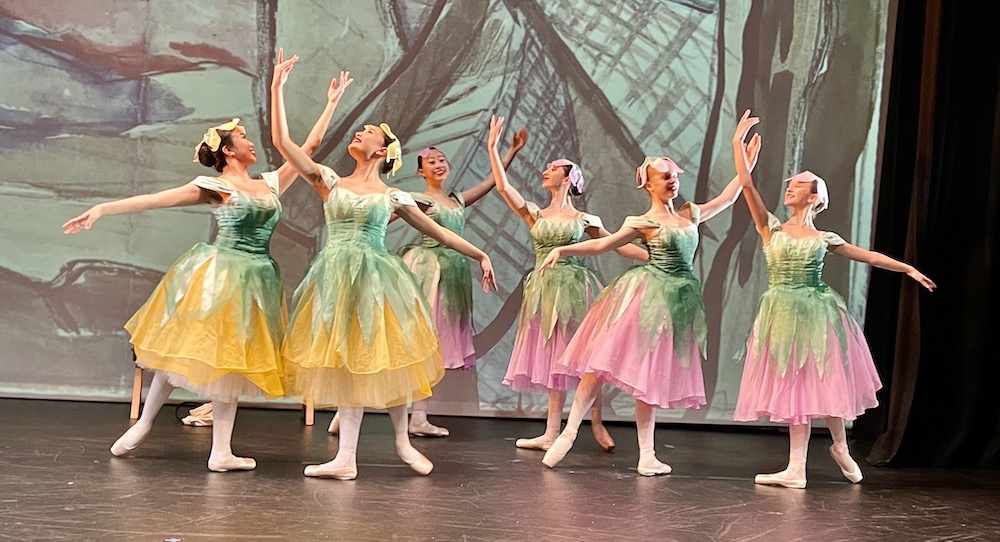Lennox Theatre, Riverside Theatres, Sydney.
15 August 2024.
Gold is a new classical ballet work, created by Simonne Smiles, who both produced and choreographed the work. Smiles originally created an excerpt for the ballet back in 2019, and has since weathered the Covid pandemic to bring about a more full-length version of the work, in the form of a 45-minute children’s ballet.
Originally written in the 1950s by Smiles’ grandmother, Marjorie Kunze, Gold is the stuff of Australian fairy tales, reminiscent of the characters of May Gibbs’ legendary gumnut babies, and other homegrown stories such as The Magic Pudding or Blinky Bill, but without the anthropomorphic animals. Smiles’ characters do all their communication through the choreography and expression, a specific intention to use the artform of classical ballet to communicate.
Gold explores 1850s Bendigo, and the heart of the gold rush era in Australia. It centres around two young Scottish immigrants, Alawyn (Callum Hendry Hodsdon) and Sheena (Mia Zanardo), and the exploration of their new Australian homeland amidst the temptation and perils of the gold rush period. The work features a myriad of Australiana characters in the form of native flora and fauna, as well as a few other characters including Chinese immigrant Loong (Kai Taberner), a shady thief (Luke Tabbernal) and his barmaid sidekick (Samantha Wong). The two young immigrants marry in the bush, overcoming their struggles, with the help of the bush characters, specifically a cheeky cockatoo (Bella Collishaw).
The costumes are created off a collection of drawings by Una Hollingworth, a friend of Kunze, who originally drew designs of costumes for the work. Laura Bailey and Nina Prive have carefully studied and replicated costumes from the drawings, creating a beautiful collection of colourful tutus, unitards, and clothing that creatively shows the unique textural aspects and personalities of the animals, birds and flowers as they might be imagined, and crafted to suit the choreography and overall shape of the work. The backdrops (Una Hollingworth and Lexie Smiles) were beautifully painted images of bush scenes, and props (James Taylor), reflected the era in a few select pieces, including a gold miners sluice box.
The score, written by APRA Music award-winning composer Me-Lee Hay, is detailed and creative. Hay has expertly crafted a score that is light, playful, incorporates bush sounds and highlights aspects of the various characters and moods of the work. It perfectly complements the choreography, telling the story along with the dance, as in ballet, all these aspects merge to become one voice.
Choreographically, Smiles has worked on creating interesting excerpts that work together to become a whole. There were some eye-catching details relating to the individual roles, with unique motifs that defined each character. For a short work, there was a lot of storytelling achieved. Some sections, such as the small group moments introducing the flowers/animals at the beginning of the work, the dramaturgy lacked specificity, compromising the ability to tell a balanced story through each movement of the work. There was also a wedding scene between the two lead characters that appeared suddenly, without appropriate build-up.
However, from here, the narrative got stronger, and we saw the tale of the migrants take off. Being told without dialogue, the story shone through the artform of ballet, and the cast’s ability to use their movement and expression to communicate with the audience, which ranged from young children through to adults, a clear tale of discovery, struggle, and triumph. There was a golden ‘will-o’-the-wisp’ character (Keira Rowe), representing the temptation and ethereal quality of the gold that was often just out of reach, and Smiles wove her cleverly in and out of the scenes, an ever-present reminder of the elusiveness of success in gold mining. Use of this role was rather interesting and well placed throughout the work. Rowe had a quality about her that oozed otherworldliness every time she entered the stage.
The cast consisted of a strong selection of very talented young classical dancers. They were technically strong and beautifully expressive, an absolute delight to watch. They captured Smiles’ vision, brought it to life, and performed their roles with maturity and sensitivity to the rhythm and strong musicality of the work. All the leads had an excellent grasp of their characters, and they worked together as a cast that has been performing this work together a long time. It is a shame that they did not have a larger stage to move around, but they did use the small space of the Lennox well.
Gold is an absolutely delightful work, with a strong young cast who shine. It is educational, entertaining, and uniquely Australian. For a work that was originally considered ‘too Australian’ at its conception, Gold is a sweet and nostalgic look back on an era that is famous in Australian history. It is a wonderful introduction for a young audience to the wonderful artform of classical ballet and classical music genre, and a fantastic opportunity for young and talented dancers to work in a professional environment, whilst telling this special story.
By Linda Badger of Dance Informa.

















